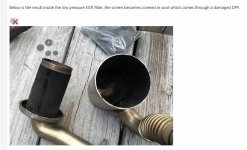- Joined
- Sep 25, 2011
- Messages
- 158
- Points
- 86
Your statement is very interesting. Maybe you can elaborate a little bit on what those dozens of issues could be (technically)? From my laymans perspective it seems that inactivating the LPEGR, if done right, will simply "downgrade" the engine from a Euro 6 to Euro 5 which of course is an issue from a non-technical perspective, but that is another question.The way of tweaked LPEGR is a dead end. A lot of measured values results of the LPEGR - if they dont match the expectations, you run into other issues. I could think of dozends.
This entry (#956) indicates that it might be doable after all (I hope we will see more reports on the outcome in the future):

Ducato P0401 P0402 P0236 P0238 and limp mode its 2017 Euro 6, EGR changed, What do I check next | FIAT Ducato
To prevent any confusion , this is my current template 4 prefered for general testing. It is designed to do specific tests and point to other templates if other specific data is required. It also works with my semi automatic spreadsheet to produce the graphs. This uses live real time data and...


